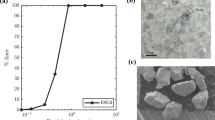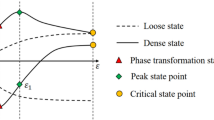Abstract
To assess the long-term integrity of geologic CO2 storage, samples modeling caprock were reacted under a supercritical CO2-water system at 10 MPa and 40 °C. The resultant effects on their sealing performance were analyzed. The use of calcite-containing artificial samples comprising silica particles with controlled size, configuration, and packing density quantified the relation between the dissolved amount of calcite and permeability. The solution analysis revealed that the calcium concentration was once increased by the initial calcite dissolution and was then decreased by calcite reprecipitation at the time of depressurization. In response to this mechanism, the initial increase and subsequent decrease in permeability were confirmed. Correlation between the Ca-leaching amount and permeability fell into two categories depending on porosity and specific surface area: The sensitivity to permeability rose when both parameters were large. This correlation was maintained also in the case in which the Ca-leaching amount changed along with the porosity change. The power-law fitting to the porosity–permeability relation suggested that two correlations were derived from the degree of heterogeneity. In actuality, the pore diameter distribution of samples with suspected heterogeneity indicated a broad peak of the spectrum, which supported the existence of heterogeneity. Using the formulated relation, the permeability increase was estimated as less than just 2%, even when calcite dissolved to its saturated concentration. Therefore, if any calcite is contained in caprock, the risk of CO2 leakage is apparently extremely low.









Similar content being viewed by others
References
Abbaszadeh, M., Nasiri, M., Riazi, M.: Experimental investigation of the impact of rock dissolution on carbonate rock properties in the presence of carbonated water. Environ. Earth Sci. 75, 791 (2016)
Akridiss, S., Tabach, E.E., Chetehouna, K., Gascoin, N., Kadiri, M.S.: Experimental transient clogging of brass porous disks by silicium particles. Exper. Therm. Fluid Sci. 98, 112–120 (2018)
Alemu, B.L., Aagaard, P., Munz, I.A., Skurtveit, E.: Caprock interaction with CO2: a laboratory study of reactivity of shale with supercritical CO2 and brine. Appl. Geochem. 26, 1975–1989 (2011)
Al-Khulaifi, Y., Lin, Q., Blunt, M.J., Bijeljic, B.: Reaction rates in chemically heterogeneous rock: coupled impact of structure and flow properties studied by X-ray microtomography. Environ. Sci. Technol. 51, 4108–4116 (2017)
Amann-Hildenbrand, A., Bertier, P., Busch, A., Krooss, B.M.: Experimental investigation of the sealing capacity of generic clay-rich caprocks. Int. J. Greenhouse Gas Control 19, 620–641 (2013)
Andreani, M., Gouze, P., Luquot, L., Jouanna, P.: Changes in seal capacity of fractured claystone caprocks induced by dissolved and gaseous CO2 seepage. Geophys. Res. Lett. 35, L14404 (2008)
Bernabé, Y., Li, M., Tang, Y.-B., Evans, B.: Pore space connectivity and the transport properties of rocks. Oil Gas Sci. Technol. 71, 50 (2016)
Bildstein, O., Kervévan, C., Lagneau, V., Delaplace, P., Crédoz, A., Audigane, P., Perfetti, E., Jacquemet, N., Jullien, M.: Integrative modeling of caprock integrity in the context of CO2 storage: evolution of transport and geochemical properties and impact on performance and safety assessment. Oil Gas Sci. Technol. 65, 485–502 (2010)
Busch, A., Alles, S., Gensterblum, Y., Prinz, D., Dewhurst, D.N., Raven, M.D., Stanjek, H., Krooss, B.M.: Carbon dioxide storage potential of shales. Int. J. Greenhouse Gas Control 2, 297–308 (2008)
Carman, P.C.: Fluid flow through granular beds. Trans. Inst. Chem. Eng. 15, 150–166 (1937)
Carroll, S., Hao, Y., Smith, M., Sholokhova, Y.: Development of scaling parameters to describe CO2–rock interactions within Weyburn-Midale carbonate flow units. Int. J. Greenhouse Gas Control 165, 5185–5193 (2013)
Ellis, B.R., Fitts, J.P., Bromhal, G.S., McIntyre, D.L., Tappero, R., Peters, C.A.: Dissolution-driven permeability reduction of a fractured carbonate caprock. Environ. Eng. Sci. 30, 187–193 (2013)
Garing, C., Gouze, P., Kassab, M., Riva, M., Guadagnini, A.: Anti-correlated porosity–permeability changes during the dissolution of carbonate rocks: experimental evidences and modeling. Transp. Porous Med. 107, 595–621 (2015)
Gherardi, F., Xu, T., Pruess, K.: Numerical modeling of self-limiting and self-enhancing caprock alteration induced by CO2 storage in a depleted gas reservoir. Chem. Geol. 244, 103–129 (2007)
Ghezzehei, T.A.: Linking sub-pore scale heterogeneity of biological and geochemical deposits with changes in permeability. Adv. Water Resour. 39, 1–6 (2012)
Hao, Y., Smith, M., Sholokhova, Y., Carroll, S.: CO2-induced dissolution of low permeability carbonates, part II: numerical modeling of experiments. Adv. Water Resour. 62, 388–408 (2013)
Hommel, J., Coltman, E., Class, H.: Porosity–permeability relations for evolving pore space: a review with a focus on (bio-)geochemically altered porous media. Transp. Porous Med. 124, 589–629 (2018)
Kozeny, J.: Über kapillare Leitung des Wassers im Boden. Sitzungsber Akad Wiss Wien 136, 271–306 (1927)
Liu, F., Lu, P., Griffith, C., Hedges, S.W., Soong, Y., Hellevang, H., Zhu, C.: CO2–brine–caprock interaction: reactivity experiments on Eau Claire shale and a review of relevant literature. Int. J. Greenhouse Gas Control 7, 153–167 (2012)
Luhmann, A.J., Kong, X.-Z., Tutolo, B.M., Garapati, N., Bagley, B.C., Saar, M.O., Seyfried, W.E., Jr.: Experimental dissolution of dolomite by CO2-charged brine at 100 °C and 150 bar: evolution of porosity, permeability, and reactive surface area. Chem. Geol. 380, 145–160 (2014)
Luquot, L., Rodriguez, O., Gouze, P.: Experimental characterization of porosity structure and transport property changes in limestone undergoing different dissolution regimes. Transp. Porous Med. 101, 507–532 (2014)
Ma, H.: Mercury intrusion porosimetry in concrete technology: Tips in measurement, pore structure parameter acquisition and application. J. Porous Mater. 21, 207–215 (2014)
Menke, H.P., Bijeljic, B., Andrew, M.G., Blunt, M.J.: Dynamic three-dimensional pore-scale imaging of reaction in a carbonate at reservoir conditions. Environ. Sci. Technol. 49, 4407–4414 (2015)
Menke, H.P., Bijeljic, B., Blunt, M.J.: Dynamic reservoir-condition microtomography of reactive transport in complex carbonates: effect of initial pore structure and initial brine pH. Geochim. Cosmochim. Acta 204, 267–285 (2017)
Murray, K.L., Seaton, N.A., Day, M.A.: Use of mercury intrusion data, combined with nitrogen adsorption measurements, as a probe of pore network connectivity. Langmuir 15, 8155–8160 (1999)
Noiriel, C., Bernard, D., Gouze, Ph., Thibault, X.: Hydraulic properties and microgeometry evolution accompanying limestone dissolution by acidic water. Oil Gas Sci. Technol. 60, 177–192 (2005)
Pereira Nunes, J.P., Blunt, M.J., Bijeljic, B.: Pore-scale simulation of carbonate dissolution in micro-CT images. J. Geophys. Res Solid Earth. (2015). https://doi.org/10.1002/2015JB012117
Rötting, T.S., Luquot, L., Carrera, J., Casalinuovo, D.J.: Changes in porosity, permeability, water retention curve and reactive surface area during carbonate rock dissolution. Chem. Geol. 403, 86–98 (2015)
Schmitt, M., Fernandes, C.P., da Cunha Neto, J.A.B., Wolf, F.G., dos Santos, V.S.S.: Characterization of pore systems in seal rocks using nitrogen gas adsorption combined with mercury injection capillary pressure techniques. Mar. Petrol. Geol. 39, 138–149 (2013)
Smith, M.M., Sholokhova, Y., Hao, Y., Carroll, S.A.: CO2-induced dissolution of low permeability carbonates, part I: characterization and experiments. Adv. Water Resour. 62, 370–387 (2013)
Song, J., Zhang, D.: Comprehensive review of caprock-sealing mechanisms for geologic carbon sequestration. Environ. Sci. Technol. 47, 9–22 (2013)
Sorai, M., Ohsumi, T., Ishikawa, M., Tsukamoto, K.: Feldspar dissolution rates measured using phase-shift interferometry: implications to CO2 underground sequestration. Appl. Geochem. 22, 2795–2809 (2007)
Sorai, M., Fujii, T., Kano, Y., Uehara, S., Honda, K.: Experimental study of sealing performance: effects of particle size and particle-packing state on threshold pressure of sintered compacts. J. Geophys. Res. Solid Earth 119, 5482–5496 (2014)
Tambach, T.J., Koenen, M., Wasch, L.J., van Bergen, F.: Geochemical evaluation of CO2 injection and containment in a depleted gas field. Int. J. Greenhouse Gas Control 32, 61–80 (2015)
Tarkowski, R., Wdowin, M., Manecki, M.: Petrophysical examination of CO2-brine-rock interactions—results of the first stage of long-term experiments in the potential Zaosie Anticline reservoir (central Poland) for CO2 storage. Environ. Monit. Assess. 187, 4215 (2015)
Weibel, R., Kjøller, C., Bateman, K., Laier, T., Nielsen, L.H., Purser, G.: Carbonate dissolution in Mesozoic sand- and claystones as a response to CO2 exposure at 70 °C and 20 MPa. Appl. Geochem. 42, 1–15 (2014)
Wollenweber, J., Alles, S., Busch, A., Krooss, B.M., Stanjek, H., Littke, R.: Experimental investigation of the CO2 sealing efficiency of caprocks. Int. J. Greenhouse Gas Control 4, 231–241 (2010)
Xu, T., Pruess, K.: Coupled modeling of non-isothermal multiphase flow, solute transport and reactive chemistry in porous and fractured media: 1. Model development and validation. Lawrence Berkeley National Laboratory Report LBNL-42050, Berkeley, California (1998)
Xu, T., Pruess, K.: On fluid flow and mineral alteration in fractured caprock of magmatic hydrothermal systems. J. Geophys. Res. 106, 2121–2138 (2001)
Yang, G., Li, Y., Atrens, A., Yu, Y., Wang, Y.: Numerical investigation into the impact of CO2-water-rock interactions on CO2 injectivity at the Shenhua CCS Demonstration Project. China. Geofluids 2017, 4278621 (2017)
Acknowledgements
This work is based on results obtained from a project (JPNP18006) commissioned by the New Energy and Industrial Technology Development Organization (NEDO) and the Ministry of Economy, Trade and Industry (METI) of Japan. Special appreciation is extended to two anonymous reviewers for providing many useful comments on a draft version of this paper. I wish to thank Munetake Sasaki for conducting numerical simulation using TOUGHREACT and also for helpful discussions. I thank Katsuya Honda and Hitoshi Kawaji for the production and evaluation of sintered compacts.
Author information
Authors and Affiliations
Corresponding author
Ethics declarations
Conflict of interest
The author declares that he has no conflict of interest.
Additional information
Publisher's Note
Springer Nature remains neutral with regard to jurisdictional claims in published maps and institutional affiliations.
Rights and permissions
About this article
Cite this article
Sorai, M. Effects of Calcite Dissolution on Caprock’s Sealing Performance Under Geologic CO2 Storage. Transp Porous Med 136, 569–585 (2021). https://doi.org/10.1007/s11242-020-01525-7
Received:
Accepted:
Published:
Issue Date:
DOI: https://doi.org/10.1007/s11242-020-01525-7




